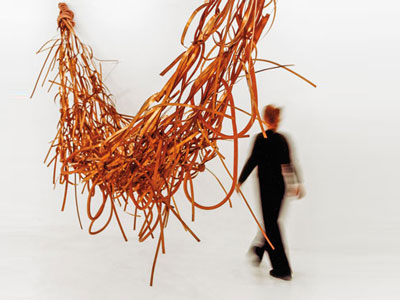Oscar D’Ambrosio
Thought in action
Internationale Sommerakademie fur Bildende Kunst, Salzburg | 2006
One of the greatest enigmas of art history-with ramifications, of course, in psychology and related sciences – is the question of what factors underlie creativity. No matter how much is written on this subject – and the theories are countless- there are three elements that combine in multiple ways: intuition, thought, and knowledge.
Starting with intuition, and taking advantage of her artistic vision and familiarity with materials, Frida Baranek uses wire, iron, wood, stone, plastic, copper, stainless steel and aluminum as her main ingredients. She creates, thus, a game of combining forms and materials, one that takes into account the tension generated between these different elements in the name of a recurring preoccupation: to render thought visible in the form of sculptural action. The apparent chaos contains the harmony of composition, the result of a dialogue between artistic restlessness, the production of an artistic object, and a reflection on what one makes and how one bridges the gap between an idea and the concrete world.
In Untitled (1985, p. 45), for example, stone, wooden boxes, and electric cables interact in such a way that lightness and lyricism are not lost but, rather, stand out. If one can speak of a grand secret in Baranek’s creative universe, it lies in the establishment of compositions and structures in which the heavy becomes light and materials, regardless of their weight, become lines. Untitled (1988, p. 50) is exemplary in how twisted metal sustains a block of stone in a burst of densely packed esthetic action.
For the Brazilian poet Hilda Hilst, art is born of the conflict between the world in which we live and the world in which we would like to live. Frida follows a course that, while not unique in Brazilian sculpture, is extremely personal, built as it is on an ongoing effort to respond to existential questions, both her own and those of her time.
The artist lies chronologically within the so called 80s Generation, which includes names that emerged during that decade, such as Ana Maria Tavares, Angelo Venosa, Nuno Ramos, Paulo Monteiro, and Sergio Romagnolo. This generation, both in painting and sculpture, was a breath of fresh air for Brazilian art, combining, to a greater or lesser degree, Brazilian concerns with the tendencies of the European avant-garde. In addition to belonging to this generation, Frida gives continuity to the work of artists from the 1970s, like Cildo Meireles and Tunga.
What distinguishes the 80s Generation, the subject of an important exhibition held in 1984 in Rio de Janeiro, is the gradual loss of influence of the conceptual rationality characteristic of the 1970s in the face of Italian transvanguardia and German neo-expressionism. This approach, less formal and more human with respect to art and life, can be seen in the works shown by Baranek in the 20th São Paulo Biennial of 1989 (left and p. 57) and in the Aperto 90 of the 44th Venice Biennial (p. 59). These visceral compositions achieve esthetic splendor precisely because rigid matter is rendered flexible and human.
These structures occupy gallery and museum spaces with elegance and alternate with diverse visual results unified by a communion of thought very much in evidence in Bolo (1990, left and p. 61), in which a piece is divided into fifteen equal parts, as if for distribution during a birthday party.
The invitation to this party lies surely in the creation of a web of images that stimulates the spectator’s always open and attentive gaze. The same can be said of Coluna Barulhenta (1990, p. 63), in which iron and travertine marble establish an atmosphere, fascinating in its mystery and questioning power, which approaches the fantastic. In this manner, immersed in esthetic components associated with thinking crystallized through sculptural action, Baranek offers her artistic response to the world.
Untitled (1991, p. 65), in which iron cables are reminiscent of female hair, shows how we can still be surprised by the manner in which materials are used, and by their ability to offer new answers to the artist’s great dilemma: how can matter be shaped by the art of making, in a mechanism full of magic, in which the relation between conductor/conducted is put into question at all times: in the moment of execution, in the result, and in the process of critical apprehension of each work.
The mixture of steel and smashed airplane pieces found in Unclassified (1992, right and p. 69) is a variation in this dialogue with reality. The idea of chaos aligns itself with that of destruction, creating a harmonic cosmos, a concept almost absurd in its essence, but that succeeds due to the artist’s sense of composition. Each work is structured by a design that guarantees equilibrium to its visual proclamation of the chaotic universe in which we live.
A greater dispersion of elements is seen in Fronteira (1995, p. 37), where a different sense of volume governs, each constituent part achieving organic relevance by how it can be seen in isolation or as the member of a set character-ized by existential unity.
The psychological issue is very present in works like Vital and Deusa Imortal (2000, pp. 85-87), in which closets store / conceal steel, bronze, latex, and sisal, creating significant images in the artist’s process of creating universes which suggest much more than they declare, and point to ways and alternatives not only of apprehension but, above all, of reflection.
Deusa Imortal , for example, unveils, inside the closet, a form made of sisal that evokes the mink coat of some Hollywood actress, more specifically the glamour that surrounds a star like Marilyn Monroe. The open closet allows entry into this world where the hidden speaks more loudly and strongly. The forbidden and the closed becomes visible and open to the public, possibly because an art gallery is not a home, and the closets, having lost their primary function of stor-ing objects, begin to show them from new vantage points.
The tubes that appear in Vital, on the other hand, emerge like tentacles ready to leave the closets and occupy the surrounding space, but that can also recoil with fear of an external world that they understand poorly. In the midst of this uncertainty, they capture the spectator’s eye, and generate dozens of questions and speculations as to the relationship between the closets and the gallery: a foreign space, yet in people’s homes a natural habitat.
Works like Tenor, Sentimental, Album, Gala, Fetal, Veto, Original, Moral, Brutal (2000, p. 37 and 91) and Hammock (2002, p. 92), bring new references, their formative elements articulating themselves like giant webs, questioning the very concept of pause and relaxation, of rest and continuity, in a poetic atmosphere that questions the role of the spectator, oscillating between passivity and unrest.
© Oscar D’Ambrosio
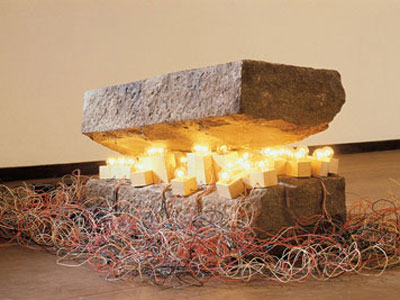
Untitled, 1985
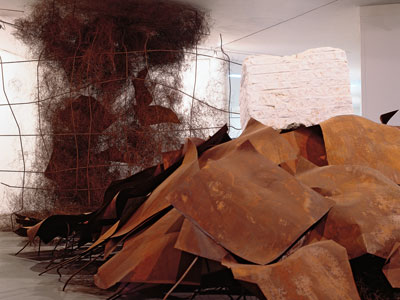
Untitled, 1988

Untitled, 1990
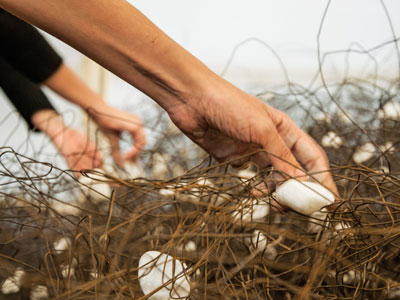
Bolo/Bolão, 1990-2013
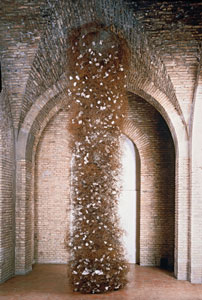
Coluna barulhenta, 1990
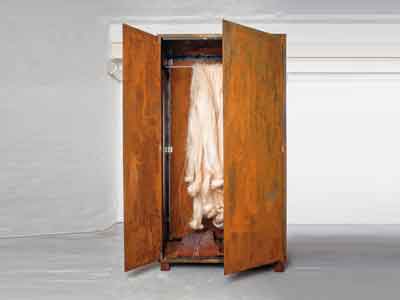
Deusa imortal, 2000
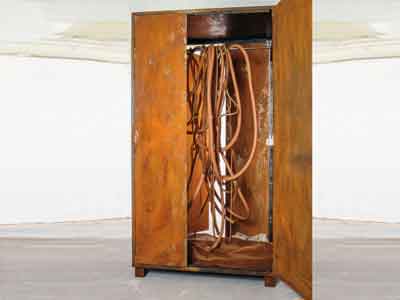
Vital, 2000
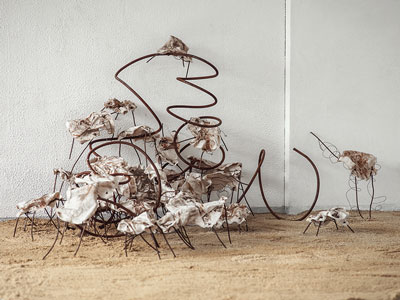
Fronteira, 1996
